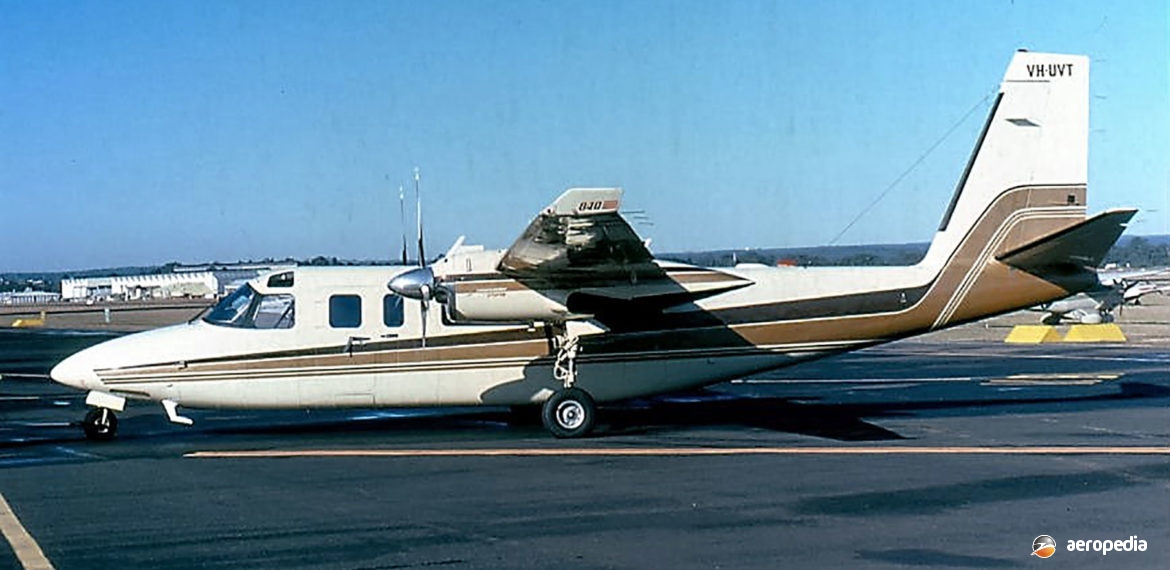Photograph:
Aero Commander 840 VH-UVT (c/n 11619) at Bankstown, NSW in July 1982 (David C Eyre)
Country of origin:
United States of America
Description:
Business and executive aircraft
Power Plant:
Two 627 kw (840 shp) Garrett AiResearch TPE-331-244K turboprops
Specifications:
- Wingspan: 15.87 m (52 ft 2 in)
- Length: 13.11 m (43 ft)
- Height: 4.55 m (14 ft 10 in)
- Max cruising speed at 6,705 m (22,000 ft): 537 km/h (334 mph)
- Cruising speed: 532 km/h (330 mph)
- Stalling speed: 139 km/h (86 mph)
- Rate of climb: 861 m/min (2,824 ft/min)
- Service ceiling: 10,378 m (34,050 ft)
- Single-engine ceiling: 6,706 m (21,000 ft)
- Take-off run: 392 m (1,286 ft)
- Landing run: 378 m (1,240 ft)
- Max range: 3,297 km (2,049 miles)
- Fuel capacity: 1,609 litres (354 Imp gals)
- Empty weight: 2,776 kg (6,120 lb)
- Useful load: 1,930 kg (4,255 lb)
- Loaded weight: 4,706 kg (10,375 lb)
History:
The Aero Commander 840, also known as the Rockwell Commander 690C Jetprop 840, was a development of the 690 series with turboprops, being produced alongside the model 980 at Rockwell International’s General Aviation Division, at this time the Company concluding production of piston-engined aircraft. The first turboprop powered Commander was the 680FLP which first flew on 31 December 1964 powered by two 451 kw (605 shp) Garrett AiResearch TPE331 engines and entered production as the 680T.
The 840 had a new drag-efficient extended wing lengthened by 1.7 m (67 inches) with winglets designed to assist with the airflow, the Company also commissioning the design of supercritical type propellers by Dowty Rotol, these being fully feathering and reversible units of 2.69 m (8 ft 10 in) diameter. Fuel capacity was increased to provide longer range, the wings outboard of the engine nacelles being fully wet, this allowing the removal of the fuselage fuel tank and a reduction in the number of wing bladders from 22 to 10. Engines installed were the TPE-331-5 providing 627 kw (840 shp) but limited for take-off and maximum continuous power to 535 kw (717.5 shp).
The 840 and its stablemate, the 980, had a number of structural changes compared to earlier variants and received their FAA type certifications in September 1979. Seating was normally for eight but nine could be carried. Rockwell stated at the time the winglets produced a 17% reduction in induced drag, a higher rate of climb, and a lower wing loading. Noise-related measures included extra insulation in the flat-sided fuselage and the Company claimed a cabin noise reduction of 50% over the previous model.
First example of the type was a demonstrator N5871K (c/n 11619) for the distributor Civil Aviation Sales, being seen around Australia in early 1980 before continuing on to its South East Asian owner. Aircraft in the series 840 registered have included: VH-BSO (c/n 11640 – ex N5892K) registered on 12 June 1981 and exported to the US on 1 May 1991 and VH-UVT (c/n 11619 – ex G-ADUP ntu) first registered on 28 May 1981 and exported to the US as N16TG on 5 July 1990.

